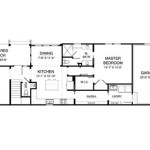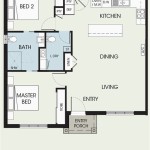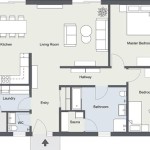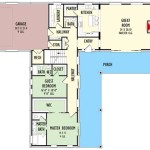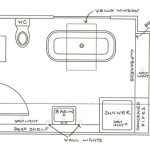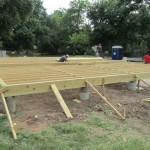Modern House Plans: 3 Bedroom Designs with Dimensions
Modern house plans emphasizing three bedrooms cater to a diverse range of homeowners, from young families to empty-nesters who desire extra space for guests or hobbies. These designs typically prioritize open-concept living areas, efficient use of space, and contemporary aesthetics. Understanding the standard dimensions and common layout options is crucial when selecting or designing a 3-bedroom modern house plan. This article provides an overview of key considerations and design elements associated with such plans.
The dimensions of a 3-bedroom modern house plan vary significantly depending on the overall square footage, architectural style, and specific needs of the occupants. However, there are some general guidelines. A modest 3-bedroom house might range from 1,200 to 1,600 square feet, while larger homes can easily exceed 2,000 square feet. The footprint of the house, the exterior dimensions, is determined by the arrangement of rooms and circulation spaces.
For example, a rectangular house with a length of 50 feet and a width of 30 feet would yield a floor area of 1,500 square feet. A two-story house with the same footprint would effectively double the available living space. The dimensions of individual rooms, such as bedrooms, living rooms, and kitchens, are determined by comfort and functionality. Master bedrooms typically require more space than secondary bedrooms. Living rooms are often designed to be expansive, encompassing dining and seating areas.
The efficiency of the floor plan is a critical factor in maximizing the use of available space. A well-designed plan minimizes wasted space, such as long hallways, and optimizes the flow between rooms. Careful consideration of furniture placement and traffic patterns is essential to ensure comfortable living.
Key Point 1: Bedroom Dimensions and Considerations
The size and layout of bedrooms significantly impact the overall functionality and comfort of a 3-bedroom house. The master bedroom, typically the largest of the three, often includes an ensuite bathroom and walk-in closet. Standard dimensions for a master bedroom range from 12 feet by 14 feet to 16 feet by 20 feet or larger, depending on the overall size of the house and owner preferences. Factors influencing these choices include the size and type of bed, the need for additional furniture like dressers and seating, and the desire for a dedicated dressing area.
Secondary bedrooms are typically smaller than the master bedroom, with dimensions ranging from 10 feet by 10 feet to 12 feet by 12 feet. These rooms are often designed to accommodate a single or double bed, a desk, and closet space. The dimensions must be sufficient to allow for comfortable movement and placement of furniture.
Closet space is an important consideration for all bedrooms. Walk-in closets are often included in the master bedroom, while secondary bedrooms typically have reach-in closets. Standard closet depths range from 24 to 30 inches. The width of the closet depends on the amount of storage required.
In modern house plans, bedroom placement aims to maximize privacy and minimize noise transmission. The master bedroom is often located at one end of the house, away from the other bedrooms. A common strategy is to place the secondary bedrooms along a hallway, with a shared bathroom situated nearby. The orientation of the bedrooms should also be considered, taking into account factors such as sunlight exposure and views.
Beyond the dimensions themselves, the arrangement of windows and doors contributes to the overall ambiance of the bedroom. Large windows maximize natural light and provide views of the surrounding landscape. Strategically placed windows also enhance ventilation. Doors should be positioned to allow for easy access and minimize disruption to furniture placement.
Modern house plans frequently incorporate design features that enhance the functionality and comfort of bedrooms. These may include built-in storage solutions, such as shelving and drawers, and designated reading nooks or seating areas.
Key Point 2: Open-Concept Living Areas: Dimensions and Integration
Open-concept living areas are a hallmark of modern house plans. These spaces typically combine the living room, dining room, and kitchen into a single, unified area. This design approach promotes social interaction, creates a sense of spaciousness, and allows for flexible use of the available space. Determining the dimensions of an open-concept living area requires careful consideration of the intended functions and the desired flow between the different zones.
The overall dimensions of an open-concept living area depend on the size of the house and the number of occupants. A typical living area might range from 400 to 800 square feet or larger. Within this space, the living room zone should be large enough to accommodate seating for the family and guests, as well as a television and other entertainment equipment. The dining room zone should be sized to comfortably seat all members of the household, with additional space for serving and circulation. The kitchen should be designed to provide ample counter space, storage, and appliance placement. Modern kitchens often incorporate islands or peninsulas that serve as both work surfaces and informal dining areas.
The key to a successful open-concept layout is to create distinct zones within the larger space without creating a formal division. This can be achieved through the use of furniture placement, changes in flooring materials, or subtle architectural details. For example, a large area rug can define the living room zone, while a change in flooring from hardwood to tile can demarcate the kitchen area.
Lighting is also an important factor in defining zones within an open-concept living area. Task lighting can be used to illuminate specific work areas in the kitchen, while ambient lighting can create a warm and inviting atmosphere in the living room. Accent lighting can be used to highlight architectural features or artwork.
In addition to the dimensions of the individual zones, the flow of traffic within the open-concept living area is crucial. The layout should allow for easy movement between the living room, dining room, and kitchen, without disrupting the activities taking place in each zone. Adequate circulation space should be provided around furniture and appliances.
Modern house plans often incorporate large windows or sliding doors in the open-concept living area to maximize natural light and provide views of the outdoors. These features can also help to blur the boundaries between the interior and exterior spaces, creating a seamless connection to the surrounding landscape. Integrating an outdoor living space, such as a patio or deck, with the open-concept living area can further enhance the sense of spaciousness and create opportunities for outdoor entertaining.
Key Point 3: Efficient Space Utilization: Bathrooms, Hallways, and Storage
Beyond bedrooms and living areas, the efficient utilization of space in bathrooms, hallways, and storage areas is paramount in modern 3-bedroom house plans. These spaces, though often smaller than bedrooms or living rooms, contribute significantly to the overall functionality and liveability of the home. Careful consideration of their dimensions and layout is essential to maximizing efficiency and minimizing wasted space.
Bathrooms in modern house plans are often designed to be compact and functional. A typical full bathroom, including a toilet, sink, and shower or bathtub, might require a minimum of 35 to 40 square feet. Master bathrooms can be significantly larger, often incorporating features such as double sinks, separate shower and bathtub areas, and dressing areas. The dimensions of these spaces are determined by the specific fixtures and features included, as well as the desired level of comfort and luxury.
The layout of a bathroom should be carefully planned to maximize space and minimize clutter. Wall-mounted toilets and sinks can save valuable floor space, while built-in storage solutions can help to keep countertops clear. The placement of fixtures should be carefully considered to ensure comfortable movement and minimize splashing.
Hallways are often viewed as necessary evils in house design, but they can be optimized to minimize wasted space. The width of a hallway should be sufficient to allow for comfortable passage, typically around 36 to 42 inches. Long, straight hallways should be avoided, as they tend to feel claustrophobic and contribute little to the overall aesthetic of the house. Instead, designers often incorporate curves or angles into hallways to create visual interest and break up the monotony. Hallways can also be used as opportunities for storage, with built-in shelving or cabinets providing additional space for books, linens, or other items.
Storage space is a critical consideration in any house plan. Modern house plans often incorporate a variety of storage solutions, including closets, pantries, and utility rooms. Closets are typically located in bedrooms and hallways, providing space for clothing, shoes, and other personal items. Pantries are located in or near the kitchen, providing storage for food and cooking supplies. Utility rooms are often located near the laundry area, providing space for cleaning supplies and other household items.
The dimensions of storage spaces should be carefully planned to meet the needs of the occupants. Closets should be deep enough to accommodate hanging clothes, typically around 24 to 30 inches. Pantries should be wide enough to allow for easy access to shelves and drawers, and tall enough to accommodate large items. Utility rooms should be large enough to accommodate washing machines, dryers, and other laundry equipment.
In addition to dedicated storage spaces, modern house plans often incorporate hidden storage solutions, such as under-stair storage or built-in shelving. These solutions can help to maximize the use of available space and minimize clutter.
By carefully considering the dimensions and layout of bathrooms, hallways, and storage areas, designers can create modern 3-bedroom house plans that are both functional and aesthetically pleasing.

3 Bedroom Contemporary Home Design Pinoy House Designs Plans Bungalow Floor

3 Bedroom House Design 2024 Beautiful Plans Modern Bungalow Plan Gallery

3 Bedroom Modern House Plan M164as Inhouseplans Com

3 Bedroom Modern House Plan M245be Inhouseplans Com
3 Bedroom House Plans Three Design Bhk Plan Civiconcepts

3 Bedroom House Design 2024 Beautiful Plans Unique Small Modern Bungalow

Check Out These 3 Bedroom House Plans Ideal For Modern Families

Low Budget Modern 3 Bedroom House Design 2d Plan

Cedar Springs Modern Ranch House Plan 3 Bed 2 Bath

Modern Three Bedroom Small House Design Ulric Home Floor Plans Simple

